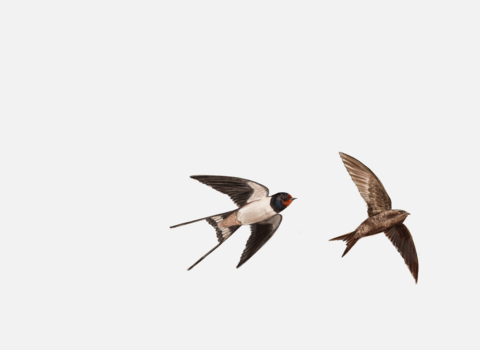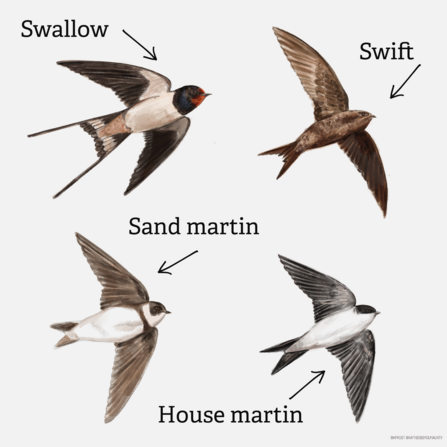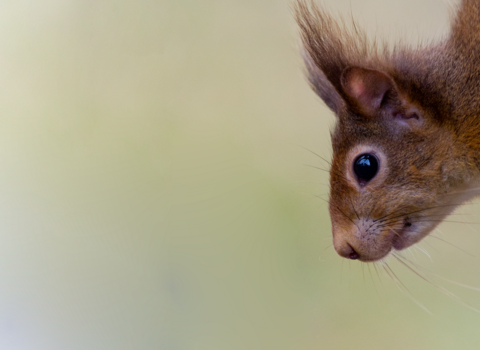How to identify swifts, swallows, sand martins and house martins
Have you spotted some beautiful silhouettes darting and diving in the summer sky? Swifts, swallows, house martins and sand martins are all summer visitors to the UK. While the swift spends most of its time soaring high in the sky, the swallow or 'barn swallow' might be seen perching on a wire, or roosting in a reedbed. Here are our top tips to work out what you might have spotted!
How to identify swifts
The swift is dark brown all over, often appearing black against the sky, with a small, pale patch on its throat. They're larger than swallows and martins, with long curving wings that make them look a bit like a boomerang when in the air. Swifts are very sociable and can often be spotted in groups wheeling over roofs and calling to each other with high-pitched screams. Unlike swallows and martins, swifts are almost never seen perching. They spend most of their lives flying – even sleeping, eating and drinking on the wing – only ever landing to nest.
Key features to tell a swift from a swallow or martin are the dark underside (swallows and martins have pale bellies), the proportionately longer wings and the screaming call.
How to identify swallows
The swallow is a glossy, dark blue-black above and creamy-white below, with a dark red forehead and throat, bordered by a blue-black band across the top of the breast. The red can be difficult to make out from a distance, when the whole head may just appear dark. It has a very long, deeply forked tail. As their full name of barn swallow suggests, they're often seen around farmland and small villages, where they nest in outbuildings. Swallows often perch up on wires in small numbers, or in larger groups as they prepare to migrate. When they aren't breeding, they can roost in huge numbers in reedbeds. They have a chattering call that often gives them away before you see them.
Key features to look for are the long forked tail, pale underside and dark-looking throat and face.
How to identify house martins
The house martin is glossy black above, completely white below, and has a white rump and a short, forked tail. As its name suggests, the house martin can be spotted around our towns and villages, where they build mud cup nests beneath the eaves of houses. They can often be seen visiting puddles to collect the mud they use to build their impressive nests.
Key features to look for are the white rump and the all-white underparts, with no dark band across the breast.
How to identify sand martins
Our smallest member of the swallow family, the sand martin is brown above and white below, with a brown band across its breast and a short, forked tail. House martins and swallows are both glossy blue-black above and don’t have the chest band. Sand martins nest in burrows, usually dug into sandy banks. They nest in colonies, with many pairs nesting close together at suitable sites. They're often seen over water, and many wetland nature reserves have built special nesting banks to give them a home.
Key features to look for are the all-brown upperparts and the dark band across the breast, separating the white throat from the white belly.















